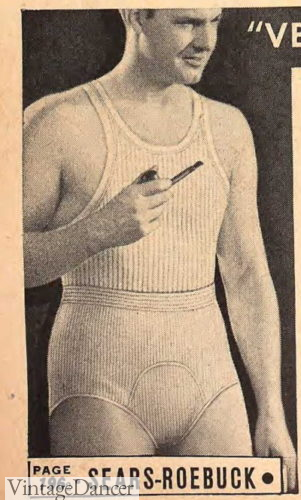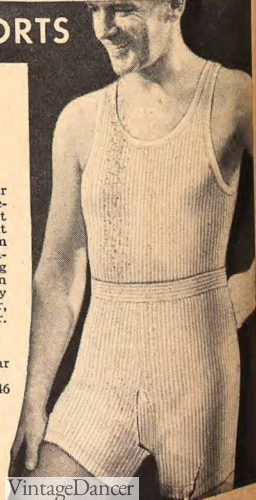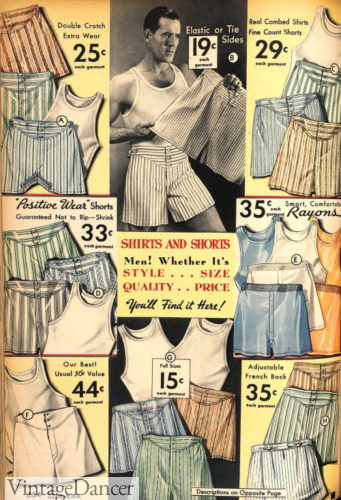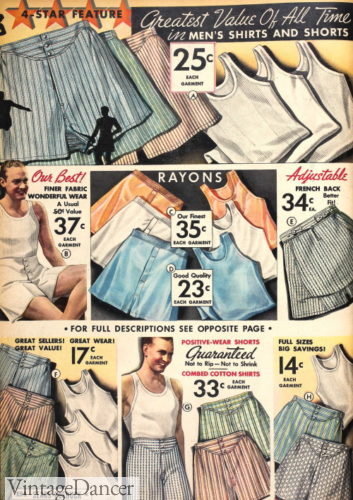Men’s 1930s underwear followed the same trends in men’s swimwear. Since both knit swimsuits and knit underwear were made by the same manufactures, this makes complete sense.
Muscular men wanted swimwear that showed off their toned and sculpted bodies. Eventually they left the swim top off for a bare chest and short-shorts look. Same for men’s underwear. Body coverage reduced and the fit became closer so that men could feel the ease and comfort of “sporty” underclothes.
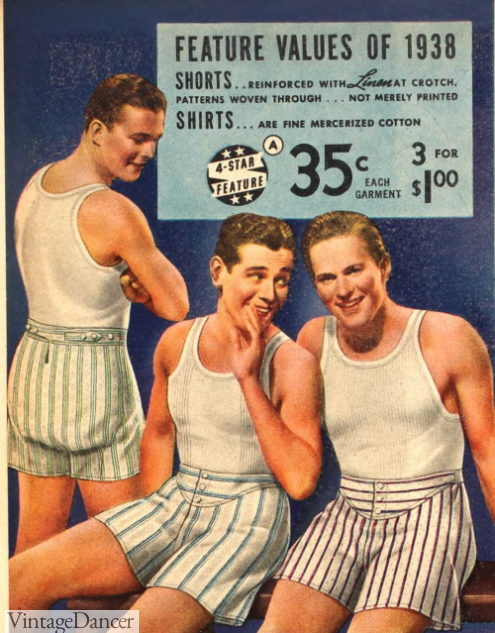
1938 Men’s Underwear – Tank Tops and Boxer Shorts
Underwear – Briefs vs. Boxers
In 1936, the Jockey Y-Front brief had built in support that promised “a no gap front opening.” It also had a flexible Lastex waistband instead of a traditional sewn waistband with button closure. Other manufactures quickly copied the designs, coming up with their own comfort briefs.
- 1936 Elastic Waistband Briefs
- 1936 Elastic Waistband Briefs with Longer Leg
The very high waist still applied to knit underwear. Some designs came with elastic panels to help reduce a maturing man’s belly.
Boxer shorts were the preferred underwear for men in the 1930s.
- 1936 Men’s Boxer Shorts
- 1936 Boxers and Undershirts
For most of the thirties, the dominant style was a yoke-front band with gathers at the back and three buttons above an open fly at the front. Metal “snaps” replaced easily broken buttons on some models. Then came the Lastex waistband without an open fly.
The “French Back” boxer featured two tabs and buttons on the backside instead of gathers or elastic. The seat was very roomy. Some boxers had pleated legs for even more roominess up front.
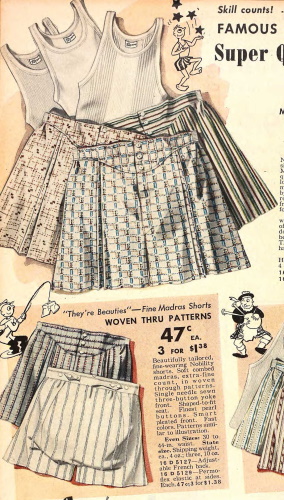
1939 French Back Boxer Shorts (Lower)
Boxers came in cotton broadcloth, cotton madras, linen, silk, and rayon. Silky fabrics reduced friction while increasing comfort. They also made it possible to offer deeper colors of peach, blue, and green. Subtle vertical stripes were very trendy on silky fabric boxers.
Cotton shorts were also colorful with solid stripes, thin candy stripes, jacquard stripes, gingham, and solid colors.
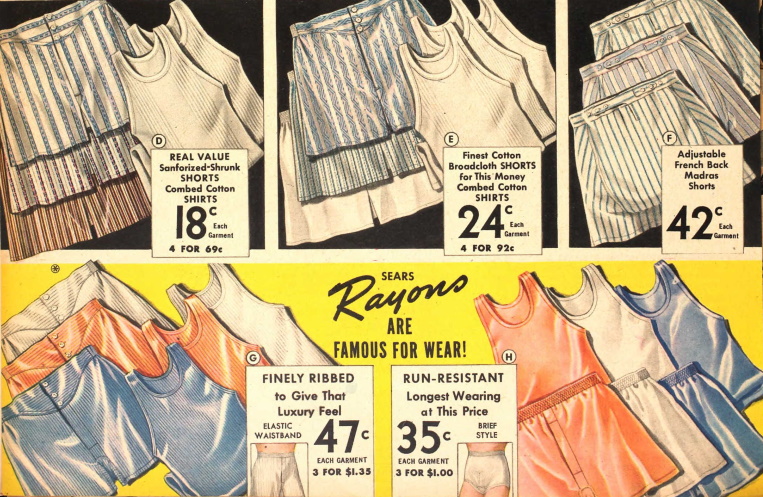
1938 Cotton and Rayon Boxer Shorts
Undershirts
The tank style undershirt was the most popular style in the thirties. Like the swimsuit top, it had very deep arm circles, thin tank top straps, and a deep round neck.
When Clark Gable removed his shirt, exposing his bare chest in It Happened One Night (1934), undershirt sales took a deep nos dive. Men experimented with going without undershirts but ultimately found them necessary. Sales returned to pre-1934 levels a few years later.
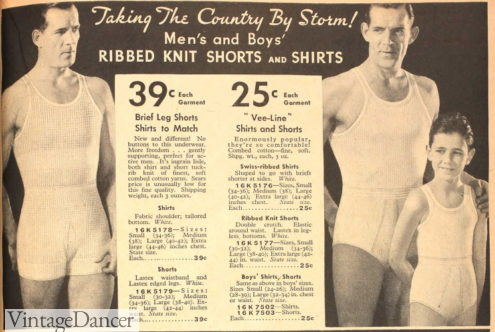
1935 Undershirts and Briefs
Combed cotton (ribbed) or cheaper lisle fabrics were worn in summer. Heavier cotton and wool blends were better for winter, although most men turned to union suits instead of sleeveless undershirts.
T-shirt style undershirts, called Gob shirts, began to appear in the late 1930s. They could be worn as undershirts or as sport shirts. They had a wide round neck and short but loose sleeves.
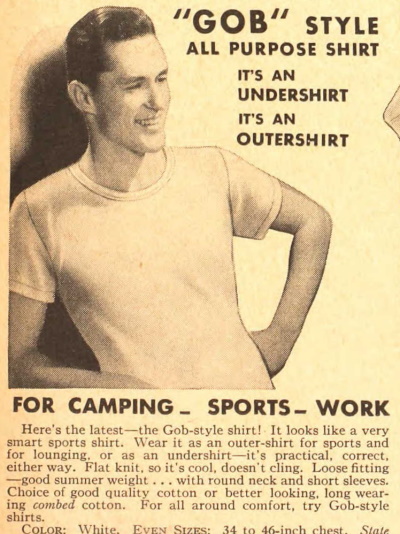
1938 T-shirt or Undershirt
Union Suits
The traditional Union Suit (Long Johns) with long or short legs and sleeves was still worn by many men in the 1930s. Winter Union Suits had long legs and long sleeves, with a long button plaquette down the front. They came in white or cream, but grey was the newer thirties color.
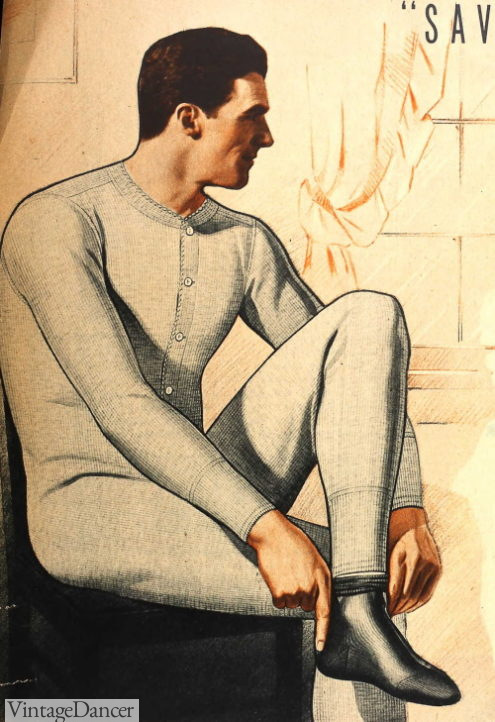
1935 Men’s Long Union Suit
Summer union suits had the look of a onesie or wrestling suit, with a step in design and thin straps. They could button down the front or had snaps on one sleeve/strap for easy on-and-off access. Short sleeved union suits with a wide cuff were made with short and long legs too.
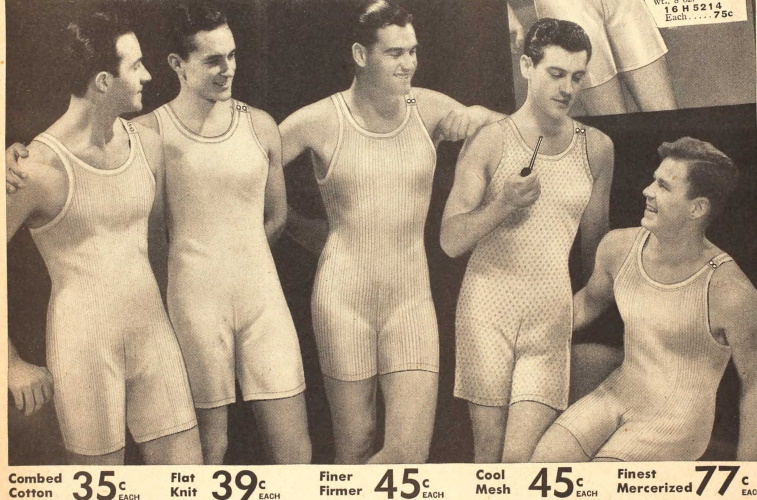
1938 Snap Sleeve Union Suits
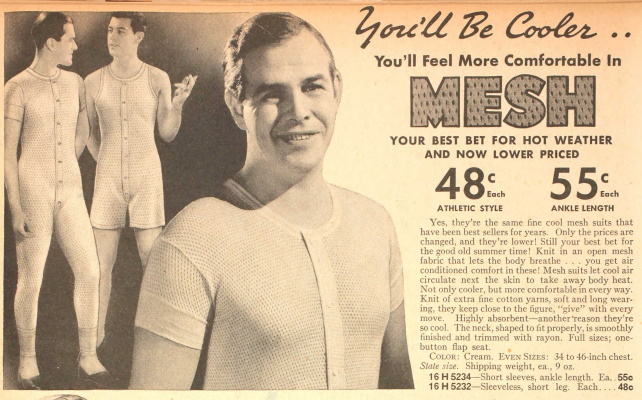
1938 Mesh Short Sleeved Union Suits
Union suit separates looked like a Henley shirt paired with yoke top long john pants, called drawers. The Henley style shirt could also be worn with boxers, although I have yet to see this illustrated.
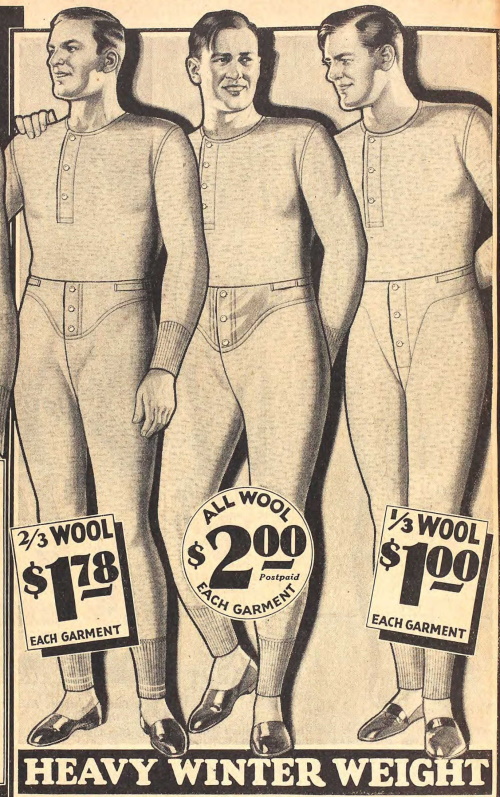
1932 Union Suit Separates – Henly Shirts and “Drawers” (Long Pants)
Continue reading about 1940s men’s underwear.
Men’s Vintage Style Underwear Brands
Look here for vintage and classic styles of men’s underwear and union suits.
- Brooks Brothers – Classic boxers, French back boxers, undershirts, socks.
- Fogey Unlimited on Esty – Yoke front boxers.
- Sunspel – Some classic boxer shorts and undershirts.
- Uniqlo – Affordable essentials, classic cuts, made in Japan.
- Brycelands (HK) – French boxers, button down undershirt, pajamas.
- Darcy Clothing (UK) – Historical reproduction undershirts, long johns, vests, singlet, cotton boxers.
- Gota Waesche (DE) – Cotton Henley shirts, underwear, boxers, knitwear.
Debbie Sessions has been teaching fashion history and helping people dress for vintage themed events since 2009. She has turned a hobby into VintageDancer.com with hundreds of well researched articles and hand picked links to vintage inspired clothing online. She aims to make dressing accurately (or not) an affordable option for all. Oh, and she dances too.
